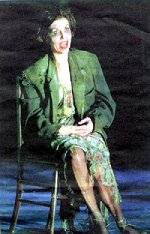Justly or unjustly neglected?
ENO is giving us a chance to make up our own minds with a brilliant staging of this 'other Bohème as part of their Italian season.
First performed in 1897, a year after Puccini's opera dealing with the same theme based on a novel by Henry Murger 'Scènes de la vie de bohème'. Ruggero Leoncavallo's version has been eclipsed by Puccini's and was not premiered in the UK until 1970.
Under the direction of Tim Albery the social context surrounding the original (and continuing) appeal - as well as apprehension - of Bohemia as a concept is realised visually with stunning economy of means. We witness first grey-uniformed workers, their backs to the audience, sitting isolated behind each other in a row and bent over their individual desks along the gangways stretching around the auditorium at the circle-level (a fixture in the imaginative permanent 'Lazaridis stage set' for the ENO Italian series). A clock is heard ticking and an image of constraint and conformity and of a diligent workforce is set up. However, control of the imagination can never be total. As soon as the bell rings for a lunch break, these workers, and, by extension, we the audience, are released into a fantasy of Bohemia on stage, and the music begins with the scene upstairs at the Café Momus.
Part of the fascination of Bohemia lies in its representation as freedom from social constraints and as an antidote to the work ethic, which evolved with industrialisation and which demanded subjection of the self to a 'greater' social and economic entity, to create a powerbase for the smooth functioning of an industrialised social order. An escape into a real or imaginary Shangri-La could act as a safety valve for pent-up frustrations and rebellious feelings. However, these escapes could/can-not be represented as too tempting. Bohemia must have its flaws exposed, lest audience members be tempted away from their allotted mundane way of life. An irregular, so-called free life style had/has to be linked with danger, poverty, squalor, social ostracism, sickness and/or death. All of these are present in this opera.
There are some problems with the libretto, written by the composer. The dramatic sequencing and interlocking leaves something to be desired. Whilst it is interesting that different figures (from Puccini's La Boheme) are given prominence, some of the characters are not fully developed or deployed functionally thereby creating a lack of identification and a lack of emotional impact. Mimi, who brings the opera to a climax, is scantily delineated earlier and upstaged by the Marcello/Musetta pair. Schaunard, the composer, who plays a pivotal role during the first half, almost vanished during the second part. Musically the two halves also seem quite separate and distinct. Rather halting and episodic at first, the music only assumes intensity and fluidity once the descent has started for real and our pity has been enlisted.
However, these flaws have been minimised through a well thought out and ravishingly beautiful visual presentation. The costumes by Jan Morrell speak volumes about each of the characters and the events shaping their lives, from the over-the-top inventive seamstress, Eufemia, appearing as a bauble-bedecked Christmas tree, to Schaunard exposing his starry blue underpants during the wild party scene, and to Mimi's fine quality but tattered clothes at her final appearance.The lighting too, designed by Jean Kalman, told its own story in its own dazzling way. The semi-opaque plastic curtain, acting as a cheap room divider during the first part, assumed an unearthly life, at first mesmerising in its brilliance, sparkling with coppery golds and orange-browns, but imperceptibly losing light and colour as Mimi's life ebbed away. The minimal props functioned extremely well as a credible setting within the overall 'Lazaridis building site'.
Paul Whelan gave a dazzling and well sung performance as Schaunard. Christine Rice brought depth of understanding and a beautiful mezzo voice to the character of Musetta and Sandra Ford emerged from the relative obscurity of the first half to establish a finely characterised and fragile Mimi. Rhys Meirion as Marcello and Leigh Melrose as Rodolfo contributed to the shaping of a well rounded musical performance of this Cinderella of an opera and the orchestra under Mark Shanahan, helped to create a most memorable evening.
ENO's gamble has paid off. Leoncavallo's La Bohème may not be a gem of diamond quality, but the company must be congratulated for bringing this unfamiliar work to our attention with such conviction and loving care.
Alexa Woolf
Leoncavallo's La Bohème is recorded complete on Orfeo C023822H.

 Return to:
Return to: